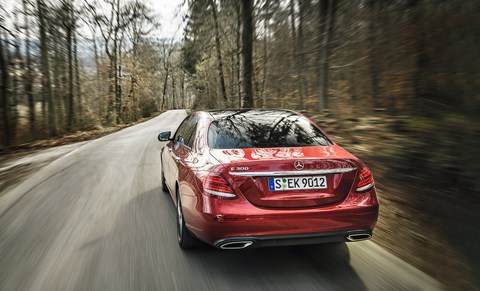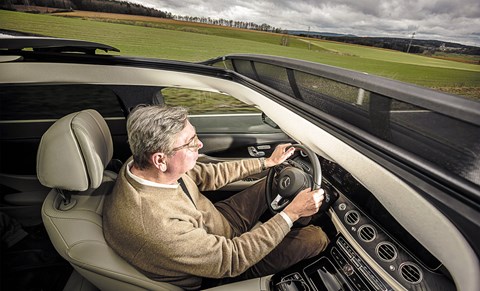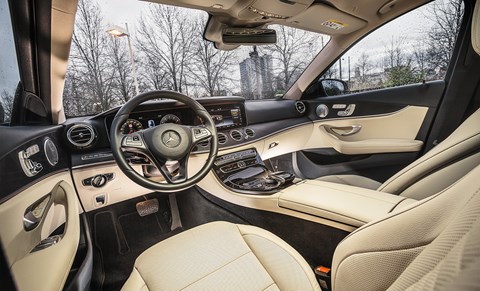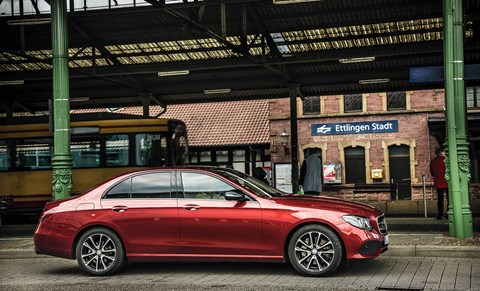► We drive the all new Mercedes E-class
► Masses of modern kit, superb interior
► Plenty of traction, decent punch
Our test car has little in common with the no-frills E-classes ordered by Joe Avis and Frank Taxi. Quite the contrary: it is a fully loaded demonstrator of fresh strokes of genius, an awesome high-tech package priced accordingly.
The MkV E-class is also aerodynamically more efficient, livelier and cheaper to run than before. Adding 65mm in length and 45mm in wheelbase, it should also be roomier, but the numbers show no gain in cabin or boot space. Instead, the more sculptured dashboard, centre console and door panels take away a couple of valuable millimetres.
We expected our car to create quite a bit of a stir in weekend traffic, but nobody noticed. A good thing? Will the evolutionary design still look fresh enough in three, four or five years? Or is there a clever time delay built into the awareness process?
Even though the E300 badge suggests plenty of cylinders, power and torque, the bonsai kraftwerk under the table-tennis-table bonnet is actually a raspy turbocharged 2.0-litre four which delivers 245bhp and 273lb ft of torque.
Initially the UK is not getting this engine – instead the 192bhp E220d comes first, to be followed later in the year by the 3.0-litre E350d and E350e plug-in hybrid (with four-pot petrol power). The standard auto transmission can select from nine gears, by black box order or via active paddleshift command.
Always eager to please, the 2.0-litre rests pleasantly light on the front axle. Depending on the chosen drive mode, it can be a hush-quiet background singer or a guttural baritone that keeps resonating in your ears. Sport+ mode may be too many revs too often, but Sport manages the transition from energetic to relaxed with bravura.

Kickdown from fourth or fifth generates a substantial punch which carries the torque curve through the gears, barely pausing for breath during upshifts. This blend of pulling power and stamina is a confidence-building asset during A-road acceleration sprints and it summons enough high-end autobahn panache to outperform the flock of flat-out repmobiles.
The E300 can do the 0-62mph sprint in 6.3sec, and it will eventually hit an indicated 155mph. Consumption? About 26.8mpg on a mixed bag of roads tackled with inspiration, 42.8mpg on that wishful-thinking lab cycle.
When put to the test on challenging roads the new E-class shows mature dynamic strengths while at the same time boasting breakthroughs in terms of digitalisation and autonomous driving. In doing so, it offers a longer than ever list of can-haves while refining the small batch of must-haves. Whether or not to push the like button depends on where one draws the line between progress and overkill.
Our E300 is kitted out with almost all options bar heated safety belts and a leather-wrapped speedo needle. In this spec it can do a few things no other car in its class can. Like allow the driver to briefly take the hands off the wheel at 130mph, park itself automatically via a remote-control app, self-actingly follow the vehicle in front, automatically steer through obstacles like narrow-lane roadworks at up to 80mph, overtake two seconds after the indicator was set.
Speed limits are recognised and adhered to (with an adjustable margin) if so required, congestions are an open invitation to let the car do all the driving, other road users are monitored by a network of sensors and cameras. It takes time to get used to the variety of talents, to relinquish control if only for a few seconds.

With ACC in charge, there is no more throttle or brake action required, and the steering will follow the road the best it can. At moderate speed, that’s okay. Up to 80mph the steering assistance can be more pronounced, but only until the radius tightens or when the car approaches the edge of the tarmac at too wide an angle.
If the driver ignores the grab-wheel symbol and the warning beeps that follow, the system triggers a short but abrupt uni-lateral braking manoeuvre. At the same time, a bright red symbol display confirms that you’ve reached the limit of semi-autonomous driving. Confidence-enhancing it is not.
We hit a tailback, so it’s back into semi-auto mode, the ACC set at the shortest possible distance, the active steering duly following the car in front. Until suddenly a van pulls out, closes the gap and forces our invisible co-driver to slam on the brakes. This happens again and again, because ACC is too polite for the belligerent environment. It also is emphatically CO2-friendly, cutting the engine for up to 30 seconds after a stop.
The real fun starts on some empty backroads. With ACC off and the DNA switch in Sport+, this is fast driving in its purest form. Since the digital captain has gone below deck, the steering-wheel no longer vibrates or flinches on a whim, the throttle no longer makes its own decisions, the brakes no longer intervene. It’s man and machine again, with ABS and ESP as the main on-demand electronic interfaces.
The car is equipped with Air Body Control which is Mercedes speak for the new five-chamber air suspension. It keeps the car level even when fully laden or under hard acceleration, lowers the body at speed, and is part of the Dynamic Select drive mode programme offering four settings: Comfort, ECO, Sport and Sport+. The car rides as well as a downsized S should. ECO makes no difference, but Comfort does. It blends an underlying cushiness with a remarkable damping prowess and an almost majestic stability – a broadband compliance competitors will find hard to match.
The steering is reassuringly competent. The effort is neither too light nor too meaty, the response doesn’t vary much as you wind on lock, the precision leaves little to be desired. In a way, this honest and linear tuning is nicer to live with than the over-assisted lightness of an S500 and the under-assisted pseudo-sportiness of the current E63 AMG.

We push harder. On rough blacktop it takes a sensitive chassis and intuitive controls to score points, but the E300 remains impeccably composed. Uphill through the twisties there is always enough grip to lay down torque early, enough traction to shift down into a lower gear before giving it stick, enough revs left to hold on to a gear through the longest corner. Lift-off affects the handling balance ever so slightly, pulling the nose a tad tighter towards the apex, then encouraging you to open up the steering early, and earlier still.
We’re enjoying excursions in fifth, sixth and seventh gear – who would guess that there are two more ratios to call upon? Perhaps the most valuable driver assistance element are the 168 LEDs which orchestrate the thrilling adaptive headlamp system. Like ABS and ESP, this luminous power should be part of every premium car.
Almost every item shown costs extra. Among the essential options are the all-inclusive Drive Pilot assistance system (without it, the resale value will suffer), 18 or 19in wheels, leather, the Business Pack (LED lights, heated seats, parking aid and Map Pilot), Bluetooth and the Burmester sound system.
We could also get excited about the widescreen display with Comand online, ventilated massage seats, heated armrests, head-up display and said multi-beam LEDs. The most expensive hide feels and smells good, NVH is rarely an issue, the build quality matches the brand´s reputation, the ambience strikes a credible balance between luxury and functionality.
The Comand controller is still in its usual place, but fresh momentum comes in the shape of two control pads in the steering-wheel spokes – vehicle functions on the left, infotainment on the right. Hands on the wheel, eyes on the road. Perfect.
It’s a compelling car, the new E-class. If comprehensive connectivity, state-of-the-art digitalisation and partly autonomous driving are what silver agers – the core market – want, then it delivers. When it comes to classic talents such as packaging, performance, consumption and handling, however, the gap to rivals narrows. The Giant Test will be interesting.
Did I try the E-class unplugged – in everything-off mode? You bet. And although the grunt rarely suffices to induce a proper change of attitude at speed, I’m pleased to say that through slow bends and in the wet, moderate rowdyism is there for the taking. Let’s still have fun while we can.
Up against
Better than: Audi A4 – Merc has that rear-drive frisky gene
Worse than: BMW 5-series – But the new 5 is due next year
We’d buy: BMW 530d – Sorry, Merc, it’s still the driver’s choice

The specs: Mercedes-Benz E220d (UK spec)
Price: £35,935
Engine: 1950cc 16v turbodiesel 4-cyl, 192bhp @ 3800rpm, 295lb ft @ 1600rpm
Transmission: Nine-speed auto, rear-wheel drive
Performance: 7.3sec 0-62mph, 155mph (limited), 72.4mpg, 102g/km CO2
Weight: 1680kg
On sale: Now
Love: The scale of the tech ambition
Hate: The erosion of core driving skills
Verdict: Impressive, like a robot is impressive
Rating: ****
Read more from the April 2016 issue of CAR magazine
